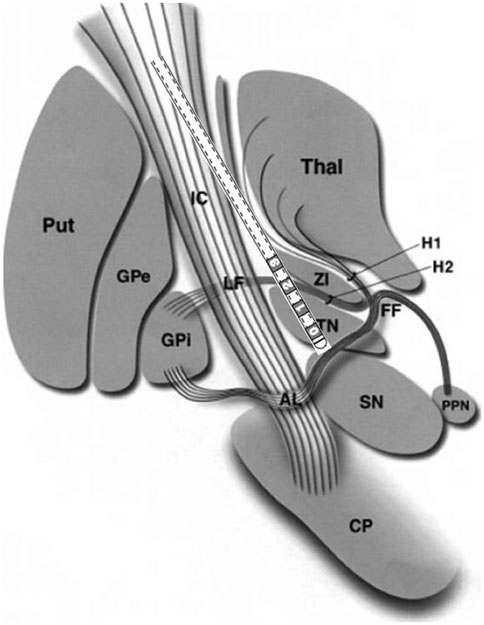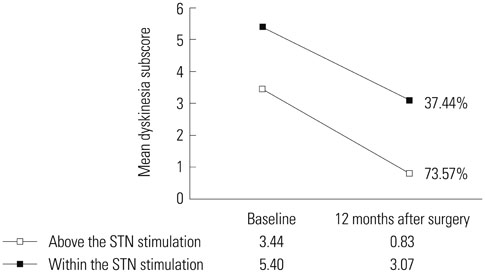Yonsei Med J.
2015 Sep;56(5):1316-1321. 10.3349/ymj.2015.56.5.1316.
Effect of Subthalamic Deep Brain Stimulation on Levodopa-Induced Dyskinesia in Parkinson's Disease
- Affiliations
-
- 1Division of Stereotactic and Functional Neurosurgery, Department of Neurosurgery, Brain Research Institute, Yonsei University College of Medicine, Seoul, Korea. JCHANG@yuhs.ac
- KMID: 2163623
- DOI: http://doi.org/10.3349/ymj.2015.56.5.1316
Abstract
- PURPOSE
To evaluate the effect of bilateral subthalamic nucleus (STN) deep brain stimulation (DBS) on levodopa-induced peakdose dyskinesia in patients with Parkinson's disease (PD).
MATERIALS AND METHODS
A retrospective review was conducted on patients who underwent STN DBS for PD from May 2000 to July 2012. Only patients with levodopa-induced dyskinesia prior to surgery and more than 1 year of available follow-up data after DBS were included. The outcome measures included the dyskinesia subscore of the Unified Parkinson's Disease Rating Scale (UPDRS) part IV (items 32 to 34 of UPDRS part IV) and the levodopa equivalent daily dose (LEDD). The patients were divided into two groups based on preoperative to postoperative LEDD change at 12 months after the surgery: Group 1, LEDD decrease >15%; Group 2, all other patients. Group 2 was further divided by the location of DBS leads.
RESULTS
Of the 100 patients enrolled, 67 were in Group 1, while those remaining were in Group 2. Twelve months after STN DBS, Groups 1 and 2 showed improvements of 61.90% and 57.14%, respectively, in the dyskinesia subscore. Group 1 was more likely to experience dyskinesia suppression; however, the association between the groups and dyskinesia suppression was not statistically significant (p=0.619). In Group 2, dyskinesia was significantly decreased by stimulation of the area above the STN in 18 patients compared to stimulation of the STN in 15 patients (p=0.048).
CONCLUSION
Levodopa-induced dyskinesia is attenuated by STN DBS without reducing the levodopa dosage.
MeSH Terms
-
Aged
Aged, 80 and over
Antiparkinson Agents/administration & dosage/*adverse effects
*Deep Brain Stimulation
Dyskinesia, Drug-Induced/*therapy
Female
Humans
Levodopa/administration & dosage/*adverse effects
Male
Middle Aged
Outcome Assessment (Health Care)
Parkinson Disease/*drug therapy
Postoperative Period
Retrospective Studies
Subthalamic Nucleus
Treatment Outcome
Antiparkinson Agents
Levodopa
Figure
Reference
-
1. Limousin P, Pollak P, Benazzouz A, Hoffmann D, Broussolle E, Perret JE, et al. Bilateral subthalamic nucleus stimulation for severe Parkinson's disease. Mov Disord. 1995; 10:672–674.
Article2. Portman AT, van Laar T, Staal MJ, Rutgers AW, Journee HL, Leenders KL. Chronic stimulation of the subthalamic nucleus increases daily on-time without dyskinesia in advanced Parkinson's disease. Parkinsonism Relat Disord. 2006; 12:143–148.
Article3. Østergaard K, Sunde N, Dupont E. Effects of bilateral stimulation of the subthalamic nucleus in patients with severe Parkinson's disease and motor fluctuations. Mov Disord. 2002; 17:693–700.
Article4. Simonin C, Tir M, Devos D, Kreisler A, Dujardin K, Salleron J, et al. Reduced levodopa-induced complications after 5 years of subthalamic stimulation in Parkinson's disease: a second honeymoon. J Neurol. 2009; 256:1736–1741.
Article5. Kleiner-Fisman G, Herzog J, Fisman DN, Tamma F, Lyons KE, Pahwa R, et al. Subthalamic nucleus deep brain stimulation: summary and meta-analysis of outcomes. Mov Disord. 2006; 21:Suppl 14. S290–S304.
Article6. Odekerken VJ, van Laar T, Staal MJ, Mosch A, Hoffmann CF, Nijssen PC, et al. Subthalamic nucleus versus globus pallidus bilateral deep brain stimulation for advanced Parkinson's disease (NSTAPS study): a randomised controlled trial. Lancet Neurol. 2013; 12:37–44.
Article7. Russmann H, Ghika J, Combrement P, Villemure JG, Bogousslavsky J, Burkhard PR, et al. L-dopa-induced dyskinesia improvement after STN-DBS depends upon medication reduction. Neurology. 2004; 63:153–155.
Article8. Herzog J, Pinsker M, Wasner M, Steigerwald F, Wailke S, Deuschl G, et al. Stimulation of subthalamic fibre tracts reduces dyskinesias in STN-DBS. Mov Disord. 2007; 22:679–684.
Article9. Valldeoriola F, Pilleri M, Tolosa E, Molinuevo JL, Rumià J, Ferrer E. Bilateral subthalamic stimulation monotherapy in advanced Parkinson's disease: long-term follow-up of patients. Mov Disord. 2002; 17:125–132.
Article10. Fraix V, Pollak P, Van Blercom N, Xie J, Krack P, Koudsie A, et al. Effect of subthalamic nucleus stimulation on levodopa-induced dyskinesia in Parkinson's disease. 2000. Neurology. 2001; 57:10 Suppl 3. S60–S62.11. Houeto JL, Damier P, Bejjani PB, Staedler C, Bonnet AM, Arnulf I, et al. Subthalamic stimulation in Parkinson disease: a multidisciplinary approach. Arch Neurol. 2000; 57:461–465.12. Welter ML, Houeto JL, Tezenas du Montcel S, Mesnage V, Bonnet AM, Pillon B, et al. Clinical predictive factors of subthalamic stimulation in Parkinson's disease. Brain. 2002; 125(Pt 3):575–583.
Article13. Molinuevo JL, Valldeoriola F, Tolosa E, Rumia J, Valls-Sole J, Roldan H, et al. Levodopa withdrawal after bilateral subthalamic nucleus stimulation in advanced Parkinson disease. Arch Neurol. 2000; 57:983–988.
Article14. Martínez-Martín P, Valldeoriola F, Tolosa E, Pilleri M, Molinuevo JL, Rumià J, et al. Bilateral subthalamic nucleus stimulation and quality of life in advanced Parkinson's disease. Mov Disord. 2002; 17:372–377.
Article15. Vesper J, Klostermann F, Stockhammer F, Funk T, Brock M. Results of chronic subthalamic nucleus stimulation for Parkinson's disease: a 1-year follow-up study. Surg Neurol. 2002; 57:306–311.
Article16. Doshi PK, Chhaya NA, Bhatt MA. Bilateral subthalamic nucleus stimulation for Parkinson's disease. Neurol India. 2003; 51:43–48.17. Ford B, Winfield L, Pullman SL, Frucht SJ, Du Y, Greene P, et al. Subthalamic nucleus stimulation in advanced Parkinson's disease: blinded assessments at one year follow up. J Neurol Neurosurg Psychiatry. 2004; 75:1255–1259.
Article18. Kleiner-Fisman G, Fisman DN, Sime E, Saint-Cyr JA, Lozano AM, Lang AE. Long-term follow up of bilateral deep brain stimulation of the subthalamic nucleus in patients with advanced Parkinson disease. J Neurosurg. 2003; 99:489–495.
Article19. Benabid AL, Benazzouz A, Limousin P, Koudsie A, Krack P, Piallat B, et al. Dyskinesias and the subthalamic nucleus. Ann Neurol. 2000; 47:4 Suppl 1. S189–S192.20. Houeto JL, Welter ML, Bejjani PB, Tezenas du Montcel S, Bonnet AM, Mesnage V, et al. Subthalamic stimulation in Parkinson disease: intraoperative predictive factors. Arch Neurol. 2003; 60:690–694.21. Vingerhoets FJ, Villemure JG, Temperli P, Pollo C, Pralong E, Ghika J. Subthalamic DBS replaces levodopa in Parkinson's disease: two-year follow-up. Neurology. 2002; 58:396–401.
Article22. Guridi J, Obeso JA, Rodriguez-Oroz MC, Lozano AA, Manrique M. L-dopa-induced dyskinesia and stereotactic surgery for Parkinson's disease. Neurosurgery. 2008; 62:311–323.
Article23. Krack P, Pollak P, Limousin P, Benazzouz A, Deuschl G, Benabid AL. From off-period dystonia to peak-dose chorea. The clinical spectrum of varying subthalamic nucleus activity. Brain. 1999; 122(Pt 6):1133–1146.
Article24. Katayama Y, Oshima H, Kano T, Kobayashi K, Fukaya C, Yamamoto T. Direct effect of subthalamic nucleus stimulation on levodopa-induced peak-dose dyskinesia in patients with Parkinson's disease. Stereotact Funct Neurosurg. 2006; 84:176–179.
Article25. Nishikawa Y, Kobayashi K, Oshima H, Fukaya C, Yamamoto T, Katayama Y, et al. Direct relief of levodopa-induced dyskinesia by stimulation in the area above the subthalamic nucleus in a patient with Parkinson's disease--case report. Neurol Med Chir (Tokyo). 2010; 50:257–259.
Article26. Alterman RL, Shils JL, Gudesblatt M, Tagliati M. Immediate and sustained relief of levodopa-induced dyskinesias after dorsal relocation of a deep brain stimulation lead. Case report. Neurosurg Focus. 2004; 17:E6.27. Brodsky MA, Hogarth P, Nutt JG. OFF-off rebound dyskinesia in subthalamic nucleus deep brain stimulation of Parkinson's disease. Mov Disord. 2006; 21:1487–1490.
Article28. Peppe A, Pierantozzi M, Bassi A, Altibrandi MG, Brusa L, Stefani A, et al. Stimulation of the subthalamic nucleus compared with the globus pallidus internus in patients with Parkinson disease. J Neurosurg. 2004; 101:195–200.
Article29. Rodriguez-Oroz MC, Zamarbide I, Guridi J, Palmero MR, Obeso JA. Efficacy of deep brain stimulation of the subthalamic nucleus in Parkinson's disease 4 years after surgery: double blind and open label evaluation. J Neurol Neurosurg Psychiatry. 2004; 75:1382–1385.
Article30. Obeso JA, Rodriguez-Oroz MC, Rodriguez M, DeLong MR, Olanow CW. Pathophysiology of levodopa-induced dyskinesias in Parkinson's disease: problems with the current model. Ann Neurol. 2000; 47:4 Suppl 1. S22–S32.31. Rodriguez-Oroz MC, Obeso JA, Lang AE, Houeto JL, Pollak P, Rehncrona S, et al. Bilateral deep brain stimulation in Parkinson's disease: a multicentre study with 4 years follow-up. Brain. 2005; 128(Pt 10):2240–2249.
Article32. Nimura T, Yamaguchi K, Ando T, Shibuya S, Oikawa T, Nakagawa A, et al. Attenuation of fluctuating striatal synaptic dopamine levels in patients with Parkinson disease in response to subthalamic nucleus stimulation: a positron emission tomography study. J Neurosurg. 2005; 103:968–973.33. Prensa L, Cossette M, Parent A. Dopaminergic innervation of human basal ganglia. J Chem Neuroanat. 2000; 20:207–213.34. Figueiras-Méndez R, Marín-Zarza F, Antonio Molina J, Jiménez-Jiménez FJ, Ortí-Pareja M, Magariños C, et al. Subthalamic nucleus stimulation improves directly levodopa induced dyskinesias in Parkinson's disease. J Neurol Neurosurg Psychiatry. 1999; 66:549–550.35. Oyama G, Foote KD, Jacobson CE 4th, Velez-Lago F, Go C, Limotai N, et al. GPi and STN deep brain stimulation can suppress dyskinesia in Parkinson's disease. Parkinsonism Relat Disord. 2012; 18:814–818.
Article36. Hamani C, Saint-Cyr JA, Fraser J, Kaplitt M, Lozano AM. The subthalamic nucleus in the context of movement disorders. Brain. 2004; 127(Pt 1):4–20.
Article
- Full Text Links
- Actions
-
Cited
- CITED
-
- Close
- Share
- Similar articles
-
- Levodopa-induced respiratory dysfunction in Parkinson’s disease managed with subthalamic nucleus deep brain stimulation
- Subthalamic Deep Brain Stimulation for Parkinson's Disease
- The Effect of Bilateral Subthalamic Nucleus Stimulation in Parkinson's Disease: Experiences From 6 Month Follow-up in Sinchon Severance Hospital
- Surgical Treatment of Advanced Parkinson Disease
- Effects of Subthalamic Nucleus Deep Brain Stimulation on the Phonation and Articulation of the Patients with Parkinson's Disease



